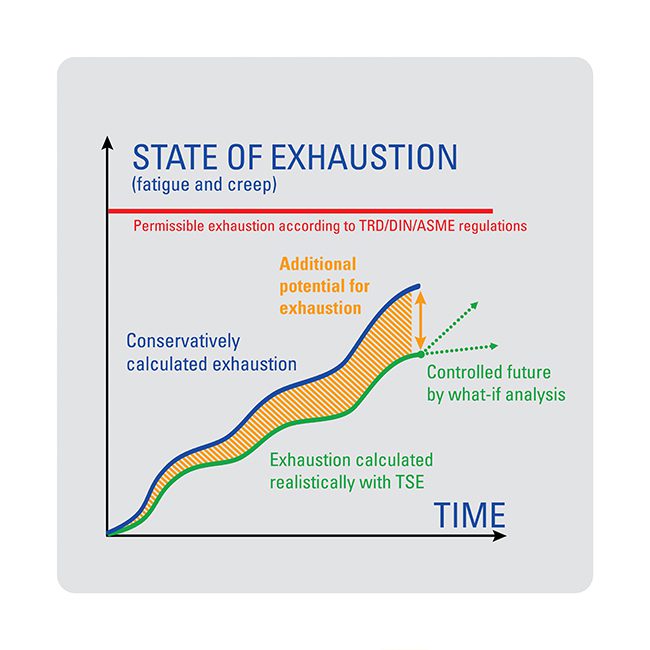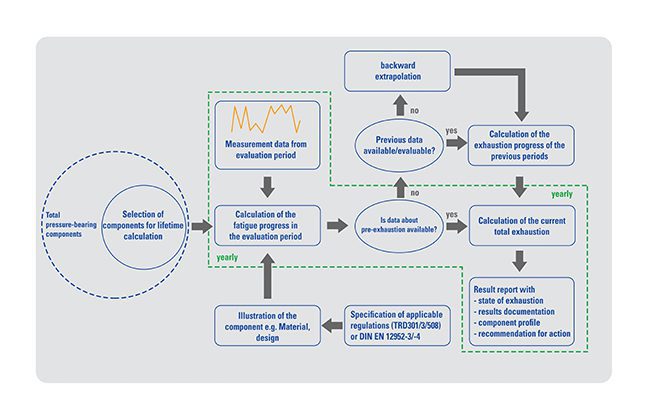Monitoring of Power Station Components: Predictive Maintenance in Flexible Plant Operation
Credit to Author: POWER| Date: Tue, 01 Mar 2022 05:09:00 +0000

An innovative software program, coupled with an experienced team of engineers, allows plant operators to evaluate creep and fatigue stress in components exposed to more frequent cycling, thereby identifying potential problems, facilitating operational changes, and reducing the risk of unexpected failure.
Flexibility of operation is becoming ever more essential for thermal power stations. However, this flexibility is accompanied by increased exposure of metal components to cyclic loads caused by changes in pressure and temperature. The risk of material fatigue grows with the length of service life, and may lead to defects in the plant as well as production losses. This issue calls for a method supporting quick and realistic analysis of component condition, to allow timely intervention and optimum planning of maintenance measures to be undertaken.
TÜV SÜD Industrie Service offers a proprietary service that caters to this need. At its core is TSE (temperature stress exhaustion), a software program designed especially for this purpose that can be applied to all plant components exposed to cyclic loads. It enables the condition of a component to be determined with a high level of efficiency, thereby limiting maintenance measures to the absolute minimum necessary.
Energy from renewable sources is characterized by volatile production patterns. Given this, significant fluctuations in the amount of energy fed into the grid may have to be balanced to ensure grid stability. This impacts on the operation of thermal power stations. They often must be run in a significantly more flexible manner and outside their design parameters. Originally designed for baseload operation, in the future these power stations will increasingly have to operate dynamically at medium- and peak-load—quite frequently including minimum load.
New Modes of Operation Leave Their Mark
These new modes of operation were not generally considered in the original design of the plants. Flexibility in terms of capacity and the associated changes in the modes of operation cause a growing number of more pronounced operational transients. These, in turn, result in a higher risk of fatigue damage in components. Most prone to this type of damage are fluid-conveying components and fittings in the water-steam cycle, such as those installed in boilers, coolers, collectors, drums, or superheaters.
Also important to note is that more flexible plant operation with modified startup and shutdown transients, and changed points of operation, frequently causes secondary load transients of a type that had likewise not been incorporated in the original design calculations. As an example, unfavorable control parameters in steam cooling, particularly at minimum load conditions, may lead to load cycles with higher frequencies. If this phenomenon goes unnoticed, it may result relatively quickly in incipient fatigue cracking on the component’s inner surface.
These developments lend new weight to the monitoring of component fatigue in thermal power stations. On the one hand, realistic knowledge of the state of creep fatigue plays an important role in comprehensive damage prevention; on the other, however, plant managers and operators must also be able to make full use of the service life of their plant components. Monitoring thus makes good sense because the results provide reliable information for condition-based maintenance.
Exhaustion Mechanisms
Important degradation mechanisms acting on pressurized components of the water and steam cycle include creep and fatigue, which are also referred to in technical literature as “high-temperature progressive deformation” and “progressive and localized structural damage under cyclic loading,” respectively. The combination of these two degradation mechanisms is known as creep fatigue and referred to in this article as “state of exhaustion.”
While creep is caused by static loads and depends on temperature and internal pressure, fatigue is caused by cyclic loads—in other words, changes in pressure and temperature. In the case of changes in temperature, fatigue increases in parallel to the rate of temperature changes. This is due to the following mechanism: As the thermal conductivity of the material is limited, steep temperature transients result in increasingly high temperature differences inside the component wall, which in turn give rise to mechanical stresses.
Initially, the impacts of these stresses are virtually undetectable because they first become apparent at the component’s inner surface, and there above all at points of change in wall thickness, edges, and anomalies—all areas where they are difficult to identify by non-destructive test (NDT) methods. Identification is only possible if the component is already affected by incipient cracking. The result is the occurrence of failure events, even though the responsible parties assumed they had taken reliable precautions in the form of NDT. Many of these defects and failures could have been prevented by needs-based calculation of component life.
Stress-Strain Analysis Using TSE
The TSE software developed by TÜV SÜD calculates component exhaustion (fatigue and creep) on the basis of pressure and temperature curves. TSE uses algorithms aligned to the specific regulations and standards in encapsulated functions and is fully in conformity with the applicable codes and standards. The resulting report thus also constitutes a reliable legal compliance report.
Input data required by the software include data on component geometry and materials in addition to the measured temperature and pressure loads. Within the scope of the analysis, the program uses integrated non-stationary calculation of the temperature field to model non-linear distribution of temperature across the component wall for a close network of interpolation points at any point in time throughout the analysis period. The software is also able to process temperatures measured on the component exterior. In other words, the TSE solution eliminates the need to perform complex temperature measurements on the interior wall of the component or the fluid, or even measurements of the temperature difference including determination of the temperature inside the wall. Even temporary measurements can be included in the calculation.
For plants in Germany, data analysis is aligned to technical regulations and standards harmonized across the European Union. Using offline evaluation of the measured and saved data, the solution delivers proof of whether component exhaustion is below the critical thresholds defined in DIN EN standards. The intervals of this type of creep-fatigue life analysis should be based on the state of exhaustion determined in the most recent previous analysis and the mode of plant operation. In many cases, TÜV SÜD recommends annual evaluation cycles to ensure timely inclusion of new load phenomena in the evaluation.
Offline evaluation offers significant benefits, particularly in the as-is analysis of the stresses acting on the component, which is part of the first step of the evaluation. This is because monitoring over longer continuous periods enables stress patterns to be identified.
 |
1. Workflow of offline calculation of service life. Courtesy: TÜV SÜD |
To this end, appropriate pattern recognition routines have been implemented in the TSE program. They enable critical load events to be categorized reliably and—where necessary—changes in the mode of operation to be initiated for the purpose of reducing loads. In step two of the evaluation, the program determines the actual state of component exhaustion (Figure 1). In addition, the program also informs about the fatigue reserves of the components available at this stage. The TSE software thus provides information about the remaining number of load cycles and the extent to which further changes in the mode of operation can be realized.
In a possible third step, the program models the progression of exhaustion resulting from new transient configurations, and aggregates it with the degree of creep fatigue from previous operation. This approach allows experts to define optimized transients that ensure consistent use of fatigue reserves while keeping component exhaustion below critical thresholds. The software is thus designed to determine values that are as realistic as possible, while preventing the introduction of additional safety margins that are not justified from a physical perspective and not required by standards and regulations.
Realistic Presentation of Fatigue
The calculations performed by the TSE software do not use the temperature inside the component wall, but the physically correct integral mean wall temperature. If the program used the temperature inside the component wall, the calculated Delta T would be excessive, resulting in 50% higher fatigue values. This is one example demonstrating that the phenomenon of “fake fatigue” can be avoided by consistently relying on realistic analyses instead of more conservative methods—a necessary step for further improving the flexibility of plant operation (Figure 2).
 |
2. Controlled progression of the state of exhaustion based on realistic analyses. Courtesy: TÜV SÜD |
The objective should not be to keep component exhaustion to a minimum, but to achieve controlled component exhaustion in line with the available fatigue reserves. To this end, experts could also carry out predictive what-if analyses calculating the respective progress of component fatigue for various different operating transients.
Assessing Components in the Waste-Heat Boiler
The following case study shows how TSE can be used for assessing components in power stations. TÜV SÜD was commissioned to evaluate the condition of critical components in a waste-heat boiler. The sensitivity analysis carried out in advance of the assessment identified 15 components exposed to high stresses. Using the TSE software, the experts next measured and recorded the temperature and pressure at the inner walls of the components over a six-month period by affixing sensors at strategic locations on the components.
The analysis of the measurement results showed that some components were exposed to significant cyclic loads caused by high-frequency changes in temperature and pressure at short intervals of 10 to 12 minutes. The overall load thus fluctuated up and down by a factor of 10 compared to the baseline of the underlying load level. More detailed analysis of the data revealed the high loads were due to the mixing of superheated steam and steam condensates in the cooling process to lower steam temperatures. The problem was solved when the power station manager made a small but significant adjustment to the cooling process, which reduced the major fluctuations in the components’ load profile and thereby lengthened the service life of the critical components in the waste-heat boiler.
The evaluation of component condition using TSE was subsequently continued with the aim of extending identification and monitoring of relevant fluctuations in pressure and temperature to take in further phases of plant operation. The results supplied fundamental information not only about the state of exhaustion of the individual components, but also about the condition of the system and the transients that are particularly significant for fatigue processes. This, in turn, gave the plant manager the opportunity to improve the station’s predictive maintenance procedures and thereby minimize the risk of unexpected component failure.
—Dipl.-Ing. Franz Binder (franz.binder@tuvsud.com) leads the Piping Systems and Lifecycle Analyses team at TÜV SÜD Industrie Service GmbH.
The post Monitoring of Power Station Components: Predictive Maintenance in Flexible Plant Operation appeared first on POWER Magazine.